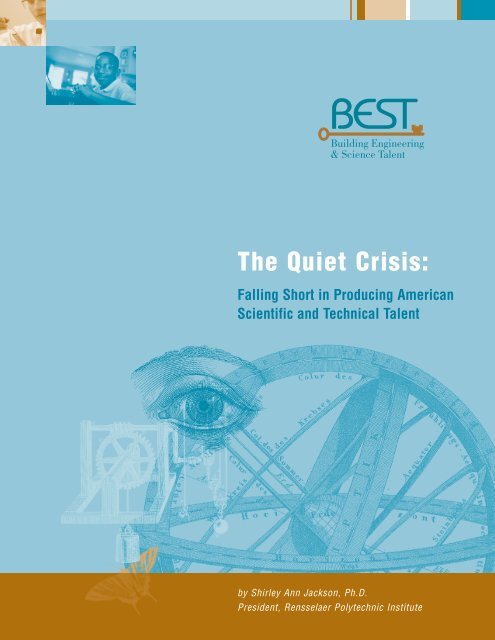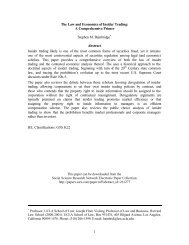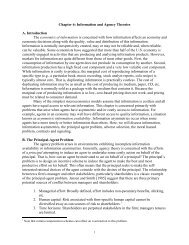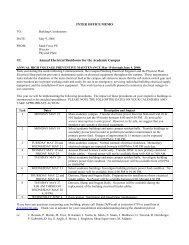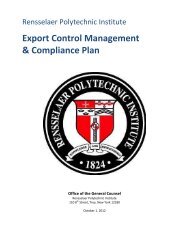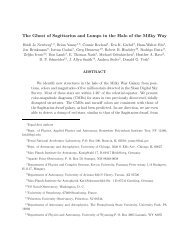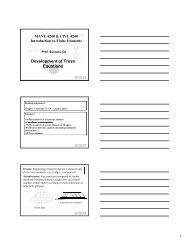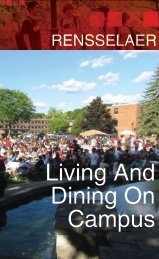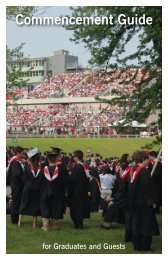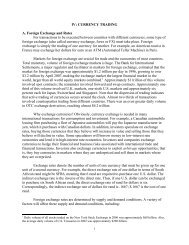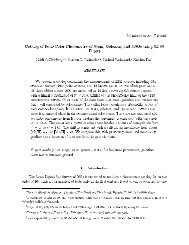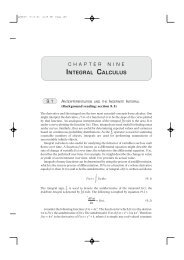Quiet Crisis - Building Engineering and Science Talent
Quiet Crisis - Building Engineering and Science Talent
Quiet Crisis - Building Engineering and Science Talent
You also want an ePaper? Increase the reach of your titles
YUMPU automatically turns print PDFs into web optimized ePapers that Google loves.
The <strong>Quiet</strong> <strong>Crisis</strong>:<br />
Falling Short in Producing American<br />
Scientific <strong>and</strong> Technical <strong>Talent</strong><br />
by Shirley Ann Jackson, Ph.D.<br />
President, Rensselaer Polytechnic Institute
Board of Directors<br />
Alfred Berkeley*<br />
Vice-Chairman<br />
NASDAQ<br />
Kathleen Buechel<br />
President <strong>and</strong> Treasurer<br />
Alcoa Foundation<br />
Mary Cirillo<br />
Chairman <strong>and</strong> CEO<br />
OPCENTER, LLP<br />
Arnold Donald<br />
Chairman <strong>and</strong> CEO<br />
Merisant<br />
Marye Anne Fox<br />
Chancellor<br />
North Carolina State University<br />
Augustine Gallego<br />
Chancellor<br />
San Diego Community College District<br />
MRC Greenwood<br />
Chancellor<br />
University of California, Santa Cruz<br />
Shirley Ann Jackson*<br />
President<br />
Rensselaer Polytechnic Institute<br />
Irwin Mark Jacobs*<br />
Chairman <strong>and</strong> CEO<br />
QUALCOMM<br />
Anne Petersen<br />
Senior Vice President for Programs<br />
W.K. Kellogg Foundation<br />
Deborah Wince-Smith<br />
President<br />
Council on Competitiveness<br />
*Member of the Executive Committee<br />
National Leadership Council<br />
Co-Chairs<br />
Rep. Eddie Bernice Johnson (D-TX)<br />
Rep. Connie Morella (R-MD)<br />
Bruce Alberts<br />
President<br />
National Academy of <strong>Science</strong>s<br />
George Boggs<br />
President <strong>and</strong> CEO<br />
American Association of<br />
Community Colleges<br />
Rita Colwell<br />
Director<br />
National <strong>Science</strong> Foundation<br />
Malcolm Gillis<br />
President<br />
Rice University<br />
Dain Hancock<br />
President<br />
Lockheed Martin Aeronautics<br />
Company<br />
Rep. Ruben Hinojosa (D-TX)<br />
Chair, Education Committee<br />
Hispanic Caucus<br />
Erle Nye<br />
CEO<br />
TXU Corporation<br />
Jill Sideman<br />
President<br />
Association for Women in <strong>Science</strong><br />
John Slaughter<br />
President<br />
National Action Council for Minorities<br />
in <strong>Engineering</strong><br />
William Wulf<br />
President<br />
National Academy of <strong>Engineering</strong><br />
National Research Board<br />
Eugene Garcia<br />
Dean, School of Education<br />
Arizona State University<br />
Shirley Malcom<br />
Head Directorate for Education<br />
American Academy for the<br />
Advancement of <strong>Science</strong><br />
Willie Pearson, Jr.<br />
Chair, School of History,<br />
Technology <strong>and</strong> Society<br />
Georgia Institute of Technology<br />
Paula Rayman<br />
Professor<br />
University of Massachusetts<br />
Richard Tapia<br />
Professor<br />
Rice University<br />
BEST is a public-private partnership<br />
dedicated to building a stronger,<br />
more diverse U.S. workforce in<br />
science, engineering <strong>and</strong> technology<br />
by increasing the participation of<br />
under-represented groups.
A quiet crisis is building in the United States.There<br />
is a rapidly growing imbalance between supply <strong>and</strong><br />
dem<strong>and</strong> of technically skilled workers.<br />
The <strong>Quiet</strong> <strong>Crisis</strong><br />
Falling Short in Producing American Scientific <strong>and</strong> Technical <strong>Talent</strong><br />
There is a quiet crisis building in the United States — a crisis<br />
that could jeopardize the nation’s pre-eminence <strong>and</strong><br />
well-being. The crisis has been mounting gradually, but<br />
inexorably, over several decades. If permitted to continue<br />
unmitigated, it could reverse the global leadership<br />
Americans currently enjoy.<br />
The crisis stems from the gap between the nation’s growing<br />
need for scientists, engineers, <strong>and</strong> other technically skilled<br />
workers, <strong>and</strong> its production of them. As the generation educated<br />
in the 1950s <strong>and</strong> 1960s prepares to retire, our colleges<br />
<strong>and</strong> universities are not graduating enough scientific <strong>and</strong> technical<br />
talent to step into research laboratories, software <strong>and</strong><br />
other design centers, refineries, defense installations, science<br />
policy offices, manufacturing shop floors <strong>and</strong> high-tech startups.<br />
This “gap” represents a shortfall in our national scientific<br />
<strong>and</strong> technical capabilities.<br />
The need to make the nation safer from emerging terrorist<br />
threats that endanger the nation’s people, infrastructure, economy,<br />
health, <strong>and</strong> environment, makes this gap all the more<br />
critical <strong>and</strong> the need for action all the more urgent.<br />
We ignore this gap at our peril. Closing it will require a national<br />
commitment to develop more of the talent of all our citizens,<br />
especially the under-represented majority - the women, minorities,<br />
<strong>and</strong> persons with disabilities who comprise a<br />
disproportionately small part of the nation’s science, engineering,<br />
<strong>and</strong> technology workforce.<br />
The American public has not focused on the quiet crisis<br />
because we have grown accustomed to the fruits of technology.<br />
The technological advances of the past 100 years created<br />
a cornucopia of riches that have dramatically altered the quality<br />
<strong>and</strong> nature of daily life. Few Americans can remember life<br />
before electricity <strong>and</strong> electronics; ground, air, <strong>and</strong> space transport;<br />
radio <strong>and</strong> television broadcast; telephonics <strong>and</strong> satellite<br />
communications; medical technologies <strong>and</strong> imaging for diagnostics,<br />
treatment, prevention, <strong>and</strong> health assurance; laser <strong>and</strong><br />
fiber optic, petrochemical, <strong>and</strong> nuclear technologies. 1<br />
A Golden Age of Prosperity<br />
The U.S.-led surge in information technology that began in the<br />
early 1990s fostered a shared sense that prosperity could be<br />
taken for granted. Then-new technologies such as the World<br />
Wide Web, e-mail, <strong>and</strong> reasonably priced microprocessors<br />
boosted American productivity <strong>and</strong> spread rapidly through<br />
most segments of the economy. Life for many Americans was<br />
comfortable, safe, healthy, convenient, relatively wealthy, <strong>and</strong><br />
thoroughly endowed with choice <strong>and</strong> consistency. The golden<br />
continuity of prosperity — together with the break-up of the<br />
Soviet Union <strong>and</strong> the triumph of market-based economics —<br />
signaled a new millennium in which the foundation of U.S.<br />
strength could be assumed.<br />
The assumption of continued progress — even American<br />
invincibility — was shattered on September 11, 2001. The hard<br />
questions that have been asked since then have centered on<br />
the immediate capacity of the nation to fight terrorism. But the<br />
current natural focus on intelligence capabilities <strong>and</strong> defense<br />
preparedness should not overshadow the most fundamental of<br />
questions. Is the United States developing the human capital to<br />
remain the world’s most productive economy while at the same<br />
time meeting a formidable new national security threat?<br />
The Council on Competitiveness, which for 15 years has studied<br />
the capacity of the nation to support high-wage jobs <strong>and</strong><br />
win in global markets, has shown how much scientific <strong>and</strong><br />
technical talent contribute to national economic performance.<br />
Greatest <strong>Engineering</strong> Achievements of the 20th Century 1<br />
1. Electrification<br />
2. Automobile<br />
3. Airplane<br />
4. Water Supply <strong>and</strong> Distribution<br />
5. Electronics<br />
6. Radio <strong>and</strong> Television<br />
7. Agricultural Mechanization<br />
8. Computers<br />
9. Telephone<br />
10. Air Conditioning <strong>and</strong><br />
Refrigeration<br />
11. Highways<br />
12. Spacecraft<br />
13. Internet<br />
14. Imaging<br />
15. Household Appliances<br />
16. Health Technologies<br />
17. Petroleum <strong>and</strong> Petrochemical<br />
Technologies<br />
18. Laser <strong>and</strong> Fiber Optics<br />
19. Nuclear Technologies<br />
20. High-performance Materials<br />
1<br />
Greatest <strong>Engineering</strong> Achievements of the 20th Century, National Academy of <strong>Engineering</strong>, www.greatachievements.org/greatachievements/indexp.html.<br />
1
The U.S.’ lengthy economic boom has hidden the<br />
fact that there is not enough technical talent in the<br />
pipeline to replace enough of the skilled labor<br />
responsible for our country’s prosperity.<br />
The Council’s regression analysis <strong>and</strong> quantitative modeling<br />
pinpoint a few critical factors that correlate highly <strong>and</strong> positively<br />
with economic strength. They include:<br />
• The size of the labor force dedicated to research <strong>and</strong><br />
development <strong>and</strong> other technically-oriented work;<br />
• The amount of investment directed at research <strong>and</strong><br />
development;<br />
• The resources devoted to higher education; <strong>and</strong><br />
• The degree to which national policy encourages investment<br />
in innovation <strong>and</strong> commercialization. 2<br />
Council researchers also identified a growing number of countries<br />
capable of world-class innovation. Beyond Japan <strong>and</strong><br />
Europe’s major economies, the Sc<strong>and</strong>inavian countries have<br />
emerged since the mid-1980s as new centers of innovation.<br />
Singapore, Taiwan, South Korea, Irel<strong>and</strong>, <strong>and</strong> Israel have<br />
also made great strides in developing high-value products <strong>and</strong><br />
services.<br />
Percent Change 1985-1995<br />
The Proportion of <strong>Science</strong> <strong>and</strong> <strong>Engineering</strong> Degrees<br />
Rose Abroad While Declining in the United States<br />
Change in <strong>Science</strong> <strong>and</strong> <strong>Engineering</strong> Degrees as a Percent of First<br />
University Degrees 1985-95<br />
12<br />
10<br />
8<br />
6<br />
4<br />
2<br />
0<br />
-2<br />
-4<br />
-6<br />
<strong>Science</strong><br />
<strong>Engineering</strong><br />
Sweden Germany Italy U.K. Australia Japan Canada U.S.A.<br />
Source: NCES, International Education Initiators: A Time Series Perspective, 1985-95, February 2000.<br />
All of these innovative economies— <strong>and</strong> others including India,<br />
China, <strong>and</strong> Malaysia that aspire to reach world-class level —<br />
are ramping up capacity to educate, train <strong>and</strong> deploy scientific<br />
<strong>and</strong> technical talent. The overseas pool of scientists <strong>and</strong> engineering<br />
talent is increasing briskly, the quality of patents by foreign<br />
inventors is strong, global access to capital is growing, <strong>and</strong> global<br />
information infrastructure is exp<strong>and</strong>ing at a rapid pace. 3<br />
These new realities are at the heart of the quiet crisis because<br />
they call American economic pre-eminence into question at a<br />
time when it is vitally needed.<br />
Success Masks Vulnerability<br />
While the U.S. has the strongest national economy with the<br />
largest per-capita income, its success masks a critical vulnerability.<br />
At home, the source of the innovative capacity <strong>and</strong><br />
technological ability is thinning. A quarter of the current science<br />
<strong>and</strong> engineering workforce – whose research <strong>and</strong><br />
innovation generated the economic boom in the 1990s – is<br />
more than 50 years old <strong>and</strong> will retire by the end of this<br />
decade. 4<br />
This cohort is not being replaced in<br />
sufficient numbers. For two<br />
decades, the U.S. college-age population<br />
declined by more than 21<br />
percent, from 21.6 million in 1980<br />
to 17 million in 2000. 5 According to<br />
data compiled by the National<br />
<strong>Science</strong> Board, graduate <strong>and</strong> undergraduate<br />
student populations in<br />
engineering <strong>and</strong> the physical sciences<br />
— despite a recent upturn —<br />
remain below levels reached in the<br />
early 1990s 6 . The same trend holds<br />
true for undergraduate <strong>and</strong> graduate<br />
degrees granted to American students<br />
in these disciplines. The only<br />
positive long-term trajectories are in<br />
the life sciences.<br />
Yet mathematics, physics, chemistry,<br />
computer sciences, <strong>and</strong> engineering<br />
will be decisive in the war against<br />
terrorism <strong>and</strong> the maintenance of<br />
economic prosperity. These are the<br />
very disciplines that support<br />
U.S. leadership in the information<br />
revolution — a vital asset in national<br />
2<br />
2<br />
Porter, Michael E. <strong>and</strong> Stern, Scott. The New Challenge to America’s Prosperity: Findings from the Innovation Index. Council on Competitiveness, Washington, D.C., 1999.<br />
3<br />
Benchmarks from the U.S. Competitiveness 2001. Council on Competitiveness. Washington, D.C.<br />
4<br />
National <strong>Science</strong> Board. <strong>Science</strong> <strong>and</strong> <strong>Engineering</strong> Indicators 2000.<br />
5<br />
Ibid.<br />
6<br />
National <strong>Science</strong> Board. <strong>Science</strong> <strong>and</strong> <strong>Engineering</strong> Indicators 2000 <strong>and</strong> Data Brief, Division of <strong>Science</strong> Resource Statistics, National <strong>Science</strong> Foundation, December 21, 2001.
The structural imbalance between America’s need for, <strong>and</strong><br />
production of, scientists <strong>and</strong> engineers, together with the<br />
risks <strong>and</strong> uncertainties of relying on imported talent, should<br />
give real urgency to the question, “who will do science in the<br />
new millennium?” 10<br />
security <strong>and</strong> the civilian economy. They<br />
are also emerging as integral to the<br />
future of the life sciences, which will<br />
remain drivers of societal well being <strong>and</strong><br />
the nation’s first line of defense against<br />
bio-terrorism. Equally, these are the<br />
disciplines that drive innovation in the<br />
pivotal energy sector.<br />
Dem<strong>and</strong> for Technical <strong>Talent</strong><br />
Remains Strong<br />
While trend lines in physical science<br />
<strong>and</strong> engineering remain flat or in<br />
decline, the dem<strong>and</strong> for technological<br />
workers is exp<strong>and</strong>ing — even in a weak<br />
economy. By the year 2008, according<br />
to projections by the U.S. Department of<br />
Labor, jobs requiring technical degrees<br />
are projected to grow at three times the<br />
rate of occupations in general. An estimated<br />
6 million job openings are<br />
projected for technically trained workers between 1998 <strong>and</strong><br />
2008, the majority of them in computer, mathematics, <strong>and</strong><br />
operations research; medical <strong>and</strong> health technology; <strong>and</strong><br />
engineering. 7 Before the end of this decade, the United States<br />
is expected to create about 2 million new jobs in science <strong>and</strong><br />
engineering. 8 There are currently 600,000 job openings in<br />
information technology alone. 9<br />
These trends <strong>and</strong> projections have not made headlines. The<br />
crisis is quiet because the nation has yet to feel the pinch.<br />
When domestic talent has been unavailable or underutilized,<br />
American industry has turned to foreign workers on H1B<br />
visas to fill the gap — as many as 195,000 per year. By the<br />
same token, U.S. research universities have educated some<br />
of the best <strong>and</strong> brightest science <strong>and</strong> engineering students<br />
from around the world — <strong>and</strong> are relying on significant numbers<br />
of them to fill faculty positions.<br />
Although the U.S. capacity to attract top talent from abroad<br />
remains a major source of strength, a risk assessment perspective<br />
is useful here:<br />
Highest Degree Held<br />
Doctorate<br />
Master's<br />
Degree<br />
Bachelor's<br />
Degree<br />
Associate's<br />
Degree<br />
High School<br />
Diploma<br />
Gr<strong>and</strong><br />
Total<br />
Challenge of Under-representation in <strong>Science</strong>, <strong>Engineering</strong>,<br />
<strong>and</strong> Technology Occupations by Race/Ethnicity<br />
Breakdown of <strong>Science</strong> <strong>and</strong> <strong>Engineering</strong> Professionals<br />
Percent Distribution by Race/Ethnicity<br />
Total<br />
593,700*<br />
1,155,700*<br />
3,223,700*<br />
657,000*<br />
1,657,000*<br />
7,287,100*<br />
African<br />
American Asian Caucasian Hispanic<br />
3.6%<br />
3.1%<br />
7.2%<br />
11.6%<br />
11.3%<br />
17.6%<br />
16.5%<br />
12.6%<br />
5.7%<br />
4.4%<br />
76.7%<br />
76.9%<br />
76.2%<br />
80.0%<br />
77.8%<br />
2.1%<br />
3.3%<br />
3.7%<br />
2.1%<br />
5.5%<br />
Native<br />
American<br />
0.0%<br />
0.2%<br />
0.3%<br />
0.5%<br />
1.0%<br />
Source: Current Population Survey, April 2001<br />
*Rounded to the nearest 100.<br />
First, reductions of as little as 5 to 10 percent in the availability<br />
of H1B visas could contribute to industrial vulnerability. A<br />
reduction of 20,000 workers may be a small number, but<br />
given the sensitivity of some of the positions <strong>and</strong> the expertise<br />
required, it can have significant impact on industrial competitiveness.<br />
Second, the quality of science <strong>and</strong> engineering education overseas<br />
is improving rapidly, as are opportunities to use this<br />
training. What if the best <strong>and</strong> brightest no longer come to the<br />
United States or return home in growing numbers?<br />
Third, in the aftermath of September 11, the inflow of foreign<br />
talent may be constrained by security concerns. The current<br />
overhaul of U.S. visa <strong>and</strong> immigration policies will — at a minimum<br />
— tighten enforcement. It may also change the rules.<br />
The structural imbalance between America’s need for, <strong>and</strong><br />
production of, scientists <strong>and</strong> engineers, together with the risks<br />
<strong>and</strong> uncertainties of relying on imported talent, should give<br />
real urgency to the question, “who will do science in the new<br />
millennium?” 10<br />
Under-represented Groups Must Become Integral<br />
Part of Technical Workforce<br />
The response to this fundamental question is clear. The United<br />
States must look increasingly within its emerging demographics.<br />
Today’s workforce of scientists <strong>and</strong> engineers no longer<br />
mirrors the national profile. White males comprise nearly 70<br />
percent of the science <strong>and</strong> engineering workforce, but just over<br />
7<br />
Council on Competitiveness, U.S. Competitiveness 2001.<br />
7<br />
Council on Competitiveness, U.S. Competitiveness 2001.<br />
8<br />
National <strong>Science</strong> Board. <strong>Science</strong> <strong>and</strong> <strong>Engineering</strong> Indicators 2000.<br />
9<br />
META Group survey based on an annual survey of 500 large American companies. As reported in The New York Times, June 15, 2001, “Technology Briefing: People: Job Market Remains<br />
Tight,” by Barnaby J. Feder.<br />
10<br />
Pearson Jr., Willie <strong>and</strong> Chubin, Daryl E., Scientists <strong>and</strong> Engineers for the New Millennium: Renewing the Human Resource, Commission on Professions in <strong>Science</strong> <strong>and</strong> Technology, 2001.<br />
3
Under-representation in the workforce is now an economic issue.<br />
Challenge of Under-Representation in <strong>Science</strong>, <strong>Engineering</strong> <strong>and</strong><br />
Technology Occupations by Gender<br />
Highest Degree Held<br />
Number<br />
Percent<br />
Male<br />
Percent<br />
Female<br />
Doctorate 593,713 79.1% 20.9%<br />
Master's Degree 1,555,659 71.6% 28.4%<br />
Bachelor's Degree<br />
Associate's Degree<br />
High School Diploma<br />
Gr<strong>and</strong> Total<br />
3,223,664 75.6% 24.4%<br />
657,444 74.1% 25.9%<br />
1,657,135 72.2% 27.8%<br />
7,287,615 74.3% 25.7%<br />
Source: Current Population Survey, April 2001<br />
40 percent of the overall workforce. White females, on the<br />
other h<strong>and</strong>, make up about 35 percent of the overall workforce,<br />
but no more than 15 percent of the science <strong>and</strong> engineering<br />
workforce. 11 Similar disproportion holds true for African<br />
Americans, Hispanics, Native Americans, <strong>and</strong> persons with disabilities<br />
who make up 24 percent of the population, but only 7<br />
percent of the science <strong>and</strong> engineering workforce. 12 Taken<br />
together, women <strong>and</strong> under-represented groups make up a half<br />
to two-thirds of the population of the United States <strong>and</strong> comprise<br />
the nation’s new majority.<br />
Far larger numbers of scientists <strong>and</strong> engineers must come<br />
from the talent pool comprised of this new majority – not to<br />
displace any group, but to exp<strong>and</strong> our capacity to innovate<br />
within a framework of inclusiveness <strong>and</strong> opportunity for all.<br />
The challenge of under-representation has been a focal point of<br />
research <strong>and</strong> action for nearly three decades. Scores of nonprofit<br />
organizations <strong>and</strong> scholars across the country have<br />
championed the cause, making limited headway with scarce<br />
resources. A number of federal agencies have invested substantially<br />
in “upping the numbers.” None of these efforts,<br />
however, has captured the full attention of national leaders or<br />
energized the American public.<br />
A sign of increased readiness to meet the challenge found<br />
expression in a recent Congressional Commission on the<br />
Advancement of Women <strong>and</strong> Minorities in <strong>Science</strong>,<br />
<strong>Engineering</strong>, <strong>and</strong> Technology Development. The report of the<br />
Commission, L<strong>and</strong> of Plenty: Diversity as America’s Competitive Edge<br />
in <strong>Science</strong>, <strong>Engineering</strong>, <strong>and</strong> Technology, marked a significant shift<br />
in the framing of the challenge. 13 The case for bringing traditionally<br />
underserved groups into the mainstream had been<br />
11<br />
Council on Competitiveness, U.S. Competitiveness 2001.<br />
12<br />
National <strong>Science</strong> Board. <strong>Science</strong> <strong>and</strong> <strong>Engineering</strong> Indicators 2000.<br />
made earlier largely in terms of affirmative action. L<strong>and</strong><br />
of Plenty, along with other reports, moved beyond this<br />
rationale by recognizing that it no longer is appropriate<br />
to consider under-representation in our society merely a<br />
social problem or a moral imperative. It is now an economic<br />
problem <strong>and</strong> a national imperative.<br />
L<strong>and</strong> of Plenty spells out issues that must be addressed<br />
along the full continuum of workforce development to<br />
increase the participation of under-represented groups.<br />
These start in grades pre-K through 12, where an alarming<br />
number of African American, Hispanic, <strong>and</strong> Native<br />
American youngsters start behind <strong>and</strong> stay behind. Only<br />
a relative h<strong>and</strong>ful graduate with skills needed for further<br />
study of science <strong>and</strong> engineering. Girls, who complete high<br />
school with the same achievement in mathematics <strong>and</strong> science<br />
as boys, nonetheless face a host of pressures that deter many<br />
from continuing further. Under-represented groups that stay<br />
the course to higher education drop out of science <strong>and</strong> engineering<br />
majors in disproportionate numbers. Comparable<br />
problems of retention <strong>and</strong> advancement persist in graduate<br />
school <strong>and</strong> beyond.<br />
Consequently, under-represented groups do not participate in<br />
the science <strong>and</strong> engineering labor force in proportion to their<br />
numbers in the overall population or labor force. If the intellectual<br />
talent inherent in this new majority were identified,<br />
nurtured, <strong>and</strong> encouraged, the projected gap of scientists <strong>and</strong><br />
engineers would be filled. 14<br />
Historical Precedent<br />
The United States has risen to meet comparable challenges<br />
before. Whenever we have, economic <strong>and</strong> national security<br />
interests invariably have converged to marshal resources <strong>and</strong><br />
build strength.<br />
The 1940s marked a growing awareness that the nation's fortunes<br />
were tied to its commitment to science, <strong>and</strong> that the<br />
security <strong>and</strong> prosperity of the nation rested, literally, on ushering<br />
more youth into the science, engineering, <strong>and</strong> mathematics<br />
pipeline. In 1944, President Franklin D. Roosevelt commissioned<br />
a high-level review of the organization of scientific<br />
research <strong>and</strong> the support of scientific education in the United<br />
States, <strong>and</strong> the consideration of what form it should take in the<br />
post-World War II environment. The review was led by Dr.<br />
Vannevar Bush, who headed the Office of Scientific Research<br />
<strong>and</strong> Development (OSRD), which played a key role in World<br />
War II.<br />
4<br />
13<br />
L<strong>and</strong> of Plenty: Diversity as America’s Competitive Edge in <strong>Science</strong>, <strong>Engineering</strong> <strong>and</strong> Technology Washington, D.C., September 2000.<br />
14<br />
Ibid.
Dr. Bush's report, <strong>Science</strong> –The<br />
Endless Frontier, made the case<br />
for long-term national investment<br />
in scientific research <strong>and</strong><br />
education in the interest of the<br />
future well-being of the United<br />
States. “Scientific progress,”<br />
wrote Dr. Bush, “is one essential<br />
key to our security as a<br />
nation, to our better health, to<br />
more jobs, to a higher st<strong>and</strong>ard<br />
of living, <strong>and</strong> to our cultural<br />
progress.” Progress to this<br />
end, according to Dr. Bush,<br />
required a partnership with<br />
what became today’s research<br />
universities, through support<br />
of basic research, <strong>and</strong> especially<br />
through the education<br />
<strong>and</strong> training of a scientific<br />
workforce.<br />
The success of the effort that followed became a model replicated<br />
several times whenever the nation perceived that its<br />
security might be compromised. When Cold War tensions<br />
arose in the late 1940s, President Harry Truman reiterated the<br />
critical role of science in defense of our national security <strong>and</strong><br />
the arms race. A decade later, in 1957, the Soviet Union<br />
launched the first earth satellite, Sputnik. Propelled not only by<br />
the arms race but also a space race, the nation rallied behind<br />
science <strong>and</strong> mathematics education as never before, focusing<br />
its efforts on nurturing youthful talent. So encouraging was the<br />
atmosphere that President John F. Kennedy, in 1961, set a goal<br />
of l<strong>and</strong>ing man on the moon by the end of the decade — a challenge<br />
the nation met, in 1969, with the Apollo 11 mission.<br />
The renewal of a post-Cold War threat to U.S. interests has<br />
sharpened the national focus on issues related to the scientific<br />
workforce. Federal government <strong>and</strong> quasi-government agencies<br />
including the National Research Council (NRC), the<br />
National <strong>Science</strong> Foundation (NSF), the National Academy of<br />
<strong>Science</strong>s (NAS), <strong>and</strong> the Government/University/Industry<br />
Research Roundtable (GUIRR) have studied the issue <strong>and</strong> are<br />
calling for action.<br />
Our Educational Foundation Needs Support<br />
A growing number of university leaders have acknowledged<br />
their responsibilities toward improving a pre-K through 12<br />
Millions of New Jobs<br />
2<br />
1.5<br />
1<br />
0.5<br />
0<br />
Six Million Job Openings Are Projected for Technically Trained <strong>Talent</strong><br />
Projected Number of Job Openings by Technical Field, New Jobs, <strong>and</strong> Net<br />
Replacements, 1998-2008<br />
Computer,<br />
Mathematical<br />
<strong>and</strong> Operations<br />
Research<br />
Medical<br />
Professionals<br />
Health<br />
Technicians<br />
Engineers<br />
<strong>Engineering</strong><br />
& <strong>Science</strong><br />
Technicians<br />
<strong>Engineering</strong><br />
& <strong>Science</strong><br />
Managers<br />
Medical<br />
& Health<br />
Service<br />
Managers<br />
Life<br />
<strong>Science</strong>s<br />
mathematics <strong>and</strong> science feeder system that does not measure<br />
up to the nation’s needs. They are joined in this arena by major<br />
foundations <strong>and</strong> corporations that recognize the scale of the<br />
challenge <strong>and</strong> are ready to do their part in meeting it.<br />
This change in national mood opens up a rare opportunity for<br />
<strong>Building</strong> <strong>Engineering</strong> <strong>and</strong> <strong>Science</strong> <strong>Talent</strong> (BEST), the public-private<br />
partnership that was incorporated a week before the<br />
attacks on the Pentagon <strong>and</strong> the World Trade Center. The establishment<br />
of such a partnership had been proposed a year<br />
earlier in the L<strong>and</strong> of Plenty report. BEST’s three-year mission<br />
is to develop <strong>and</strong> execute a national action plan to increase the<br />
participation of the “under-represented majority” — women,<br />
minorities, <strong>and</strong> persons with disabilities — in technical fields.<br />
BEST Can Help Overcome the <strong>Quiet</strong> <strong>Crisis</strong> in<br />
Several Important Areas<br />
Physical<br />
Scientists<br />
Source: Bureau of Labor Statistics, www.bls.gov<br />
Best Practices The nation needs to know what is really working<br />
in elementary <strong>and</strong> high school mathematics, freshman<br />
physics <strong>and</strong> chemistry, graduate schools, <strong>and</strong> corporate R&D<br />
teams to develop — <strong>and</strong> draw upon — the talent of under-represented<br />
groups. The same wheels are being re-invented <strong>and</strong><br />
the same mistakes made on a daily basis in every part of the<br />
country. Authoritative, readily accessible information on bestin-class<br />
<strong>and</strong> exceptionally promising programs, lessons from<br />
5
Overall Population<br />
(Working & Nonworking)<br />
U.S. Workforce<br />
White/Asian 74.3%<br />
White/Asian 79.1%<br />
<strong>Science</strong> & <strong>Engineering</strong> Workforce<br />
White/Asian 93.2%<br />
Other 0.9%<br />
Other 0.1%<br />
Other 0.3%<br />
Hispanic 12.5%<br />
African<br />
American 12.3%<br />
Source: 2000 Census<br />
Hispanic 10.1%<br />
African<br />
American 10.7%<br />
Source: Women, Minorities, Persons with Disabilities, National <strong>Science</strong> Foundation , 2000<br />
Hispanic 3.1%<br />
African<br />
American 3.4%<br />
success <strong>and</strong> failure, <strong>and</strong> insights into scaling up would be of<br />
great value to employers, educators, parents, <strong>and</strong> students.<br />
BEST has organized blue ribbon panels of nationally recognized<br />
experts in pre-K through 12, higher education, <strong>and</strong> workforce<br />
development to make these judgments.<br />
Community Engagement BEST will take its knowledge <strong>and</strong><br />
insights to communities. The quiet crisis must be addressed by<br />
leadership from the bottom up, as well as the top down. Civic<br />
leaders need practical advice on the ground. For example,<br />
BEST might provide a comprehensive checklist that enables a<br />
community to assess its capacity to develop a more diverse<br />
technical workforce. Based on its comm<strong>and</strong> of outst<strong>and</strong>ing<br />
programs <strong>and</strong> their costs, BEST could go beyond this to help a<br />
community set <strong>and</strong> implement priorities.<br />
A National Strategy BEST will link the widely shared underst<strong>and</strong>ing<br />
that U.S. interests are at risk with the specific<br />
requirement of building a stronger, more diverse pool of U.S.<br />
scientific <strong>and</strong> technical talent. The link has to be made at the<br />
national level by developing an agenda that galvanizes leaders<br />
from government, industry, education, professional societies,<br />
<strong>and</strong> the foundation community. There is no substitute for<br />
national leadership to generate the will <strong>and</strong> the resources<br />
needed to make serious headway over the next decade. As is<br />
the case with the war on terrorism, there is no quick fix for the<br />
challenge of under-representation. Equally, there is a parallel<br />
need for a cohesive national strategy. A national strategy<br />
requires a compelling vision, clear objectives, <strong>and</strong> actionable<br />
priorities.<br />
The vision that I find compelling is one of affirmative opportunity<br />
to develop the scientific <strong>and</strong> technical talents of every child<br />
in America.<br />
The objective that makes sense is to create a scientific <strong>and</strong><br />
technical workforce that reflects the changing face of America.<br />
Priorities for Action<br />
Many of the priorities <strong>and</strong> action steps needed to develop a<br />
national strategy will emerge from an assessment by BEST of<br />
what is <strong>and</strong> is not working. As the blue ribbon panels convened<br />
by BEST chart the way forward in pre-K through 12, higher<br />
education, <strong>and</strong> the workplace, they will frame recommendations<br />
for all of the sectors that have leadership roles to play at<br />
the national level. The following framework provides a starting<br />
point.<br />
Source: Bureau of Labor Statistics, 2000 www.bls.gov<br />
6
The nation needs to know what’s really working in elementary <strong>and</strong><br />
high school mathematics, freshman physics <strong>and</strong> chemistry, graduate<br />
schools <strong>and</strong> corporate R&D teams to develop – <strong>and</strong> draw upon – the<br />
talent of under-represented groups.<br />
Priorities for the Federal Government<br />
Congress <strong>and</strong> the executive branch must lead on the issue of<br />
under-representation. This will involve giving voice to the<br />
national need – <strong>and</strong> backing that voice with direction <strong>and</strong><br />
resources. Four priorities st<strong>and</strong> out:<br />
Maximize the Value of Current Programs The National<br />
<strong>Science</strong> Foundation, Department of Education, Department of<br />
Defense, Department of Energy, NASA <strong>and</strong> other agencies have<br />
longst<strong>and</strong>ing records of commitment to under-represented<br />
groups. But federal resources are scattered <strong>and</strong> would have<br />
greater impact if they were more closely aligned. An interagency<br />
initiative to insure such alignment would enhance both<br />
the effectiveness <strong>and</strong> credibility of federal investment.<br />
Other national programs, such as the National Teachers Corps<br />
which recruits up to 75,000 qualified teachers annually to serve<br />
in high-need schools, should be exp<strong>and</strong>ed <strong>and</strong> strengthened<br />
with such measures as including subsidies for the acquisition<br />
of teaching credentials.<br />
Consider a Bold Federal Initiative While such programs are<br />
important, it may be even more worthwhile to consider a bold<br />
initiative similar to the National Defense Education Act of 1958,<br />
when Congress found “that an educational emergency exists<br />
<strong>and</strong> requires action by the federal government.” 15<br />
Leverage Federal Dollars Federal investments to develop a<br />
stronger, more diverse talent pool should not st<strong>and</strong> alone, but<br />
should be matched by states <strong>and</strong> local communities. The 25<br />
states in which minorities make up at least 25 percent of the<br />
pre-K through 12 student population deserve priority attention.<br />
Increase Investment Congress <strong>and</strong> the executive branch cannot<br />
just re-divide the pie, but must allocate fresh resources to<br />
exp<strong>and</strong> educational opportunities in mathematics <strong>and</strong> science<br />
for under-represented groups. Important new initiatives, such<br />
as NSF’s five-year $1 billion Mathematics <strong>and</strong> <strong>Science</strong><br />
Partnerships, should represent net increases in investment.<br />
Programs that have a track record of proven value should be<br />
exp<strong>and</strong>ed. New investments that promise to make a real difference,<br />
such as Pell-like financial aid grants for underrepresented<br />
students in science <strong>and</strong> engineering majors,<br />
deserve serious consideration.<br />
Priorities for Education<br />
Research universities have a special leadership responsibility.<br />
Not only are they strategically positioned between pre-K<br />
through 12 <strong>and</strong> the workplace, but they will educate the<br />
successor generation of American scientists <strong>and</strong> engineers.<br />
The list of “must-do’s” for research universities should include:<br />
Strengthen the University Presence in Pre-K Through 12<br />
Mathematics <strong>and</strong> <strong>Science</strong> Education The crown jewels of the<br />
nation’s educational institutions must engage far more intensively<br />
in the feeder system. One model that is producing results<br />
entails adopting students from low-income school districts<br />
from 7th through 12th grade. These students receive advanced<br />
instruction in algebra, chemistry, physics, <strong>and</strong> trigonometry, as<br />
well as mentoring <strong>and</strong> college financial planning seminars for<br />
students <strong>and</strong> their parents. Such models should be shared<br />
among research universities, adapted as needed, <strong>and</strong> scaled<br />
nationwide. At the same time, universities should develop alternatives<br />
to the traditional admissions process to ensure that the<br />
abilities of prospective students from under-represented<br />
groups are fairly <strong>and</strong> accurately assessed.<br />
Nurture the Undergraduate <strong>and</strong> Graduate Education of Under-<br />
Represented Groups Slowing the attrition of women, African<br />
Americans, Hispanics, Native Americans, <strong>and</strong> students with<br />
disabilities will have the greatest immediate impact on the science<br />
<strong>and</strong> engineering talent pool. The causes of such attrition<br />
are understood <strong>and</strong> models exist for mitigating such attrition.<br />
The problem must be addressed by the presidents, deans,<br />
department chairs <strong>and</strong> tenured faculty who have the authority<br />
to change the learning environment.<br />
Exp<strong>and</strong> Faculty Diversity One of the greatest barriers to<br />
increasing the production of under-represented groups is the<br />
absence of role models — both in teaching <strong>and</strong> in research.<br />
Leaders of the nation’s research institutions must commit<br />
jointly to transform the composition of their junior <strong>and</strong> tenured<br />
faculties.<br />
Priorities for Industry<br />
Internationally competitive companies are the U.S. economy’s<br />
greatest assets, but many also face high-stakes choices<br />
between going global or strengthening both their R&D <strong>and</strong> production<br />
bases at home. The commitment of these companies<br />
to develop <strong>and</strong> utilize more homegrown science <strong>and</strong> engineering<br />
talent is indispensable. Their agendas should include:<br />
Strengthen the Corporate Presence in Pre-K Through 12<br />
Mathematics <strong>and</strong> <strong>Science</strong> Education Although some of the<br />
nation’s most prominent corporate leaders have set leadership<br />
examples, industry’s commitment must become a norm across<br />
the board. The professional development of mathematics <strong>and</strong><br />
science teachers in middle school <strong>and</strong> high school is a logical<br />
15<br />
National Defense Education Act of 1958, Title I.<br />
7
focal point. In addition, discipline-based teacher models that<br />
enable scientists <strong>and</strong> engineers to transition from industry into<br />
teaching have great potential value.<br />
Embed Diversity in R&D Partnerships With Universities<br />
Companies that invest in university-based research should<br />
make clear that increased diversity would enhance the value of<br />
collaboration, <strong>and</strong> that diversity is a criterion that routinely will<br />
affect the selection of future partners. Statements by the<br />
nation’s leading industry groups underscoring this point would<br />
send a powerful message.<br />
Create a Culture of Inclusiveness in the Workplace Although<br />
the business case for diversity is widely accepted, an energetic<br />
recruiting policy falls far short of what is needed to enable scientists<br />
<strong>and</strong> engineers from under-represented groups to<br />
contribute to the full measure of their abilities. Attention at the<br />
highest executive levels is a necessity in companies large <strong>and</strong><br />
small.<br />
Priorities for Non-Profit Organizations<br />
Foundations, professional societies, <strong>and</strong> the institutional advocates<br />
of under-represented groups have an important role to<br />
play at the national level. Aligning their efforts is a challenge all<br />
its own, but it is essential that leaders of these varied organizations<br />
work together to advance common interests. Their<br />
collaboration should focus on two main priorities:<br />
Project a More Positive Public Image of <strong>Science</strong>,<br />
<strong>Engineering</strong>, <strong>and</strong> Technology Making technical careers more<br />
attractive to all Americans, especially the under-represented, is<br />
a prerequisite of meaningful long-term progress. A coalition of<br />
foundations, professional societies, <strong>and</strong> other allied groups<br />
could bring powerful assets to bear in any such undertaking –<br />
financial resources <strong>and</strong> national outreach to millions of concerned<br />
individuals.<br />
Mobilize at the Grass Roots More professional societies of<br />
scientists <strong>and</strong> engineers should put diversity front <strong>and</strong> center<br />
on their agendas, taking active roles in helping university<br />
departments reduce attrition <strong>and</strong> prepare future faculty.<br />
Correspondingly, foundations could produce a national multiplier<br />
by making mathematics <strong>and</strong> science more prominent in<br />
their focus on school reform.<br />
When the critical nature of the nation’s need for adequate<br />
science <strong>and</strong> engineering capability is understood fully <strong>and</strong><br />
when the national will is engaged, the United States can <strong>and</strong><br />
will gather the resources to rebuild that workforce. With the<br />
national will engaged to resolve this quiet crisis, <strong>and</strong> with<br />
strong leadership, the nation will assure its own vitality,<br />
security, <strong>and</strong> future.<br />
BEST Blue Ribbon Panelists<br />
Best Practices in Pre-K Through<br />
12 Education<br />
Alfred Berkeley (Panel co-Chair)<br />
Vice Chairman<br />
NASDAQ<br />
Shirley Malcom (Panel co-Chair)<br />
Head, Education Directorate<br />
American Association<br />
for the Advancement of <strong>Science</strong><br />
Eugene Garcia (Expert Leader)<br />
Dean, School of Education<br />
Arizona State University<br />
Allan Alson<br />
Superintendent<br />
Evanston Township High School<br />
Raymond V. “Buzz” Bartlett<br />
President <strong>and</strong> CEO<br />
Council for Basic Education<br />
Muriel Berkeley<br />
President<br />
Baltimore Curriculum Project<br />
Susan Brady<br />
Director, Education Programs<br />
Merck Institute for <strong>Science</strong> Education<br />
Manuel Berriozábal<br />
Professor, Mathematics<br />
University of Texas at San Antonio<br />
Costello Brown<br />
Director, Division of Educational System<br />
Reform<br />
National <strong>Science</strong> Foundation<br />
Patricia Campbell<br />
President<br />
Campbell-Kibler Associates<br />
Douglas Carnine<br />
Director, National Center to<br />
Improve the Tools of Educators<br />
University of Oregon<br />
Elizabeth Cohen<br />
Professor Emerita<br />
Stanford University<br />
Mike Cohen<br />
Senior Fellow<br />
Program on Education<br />
in a Changing Society<br />
Anthony Colón<br />
Vice President<br />
National Council of La Raza<br />
Center for Community Educational<br />
Excellence<br />
Jacquelynne Eccles<br />
Chair<br />
MacArthur Foundation Research<br />
Network on Successful Pathways<br />
through Middle Childhood<br />
Charles Eilber<br />
President<br />
Charles Eilber Associates<br />
Stephanie Fanjul<br />
Director of Student Achievement<br />
National Education Association<br />
Yol<strong>and</strong>a George<br />
Deputy Director <strong>and</strong> Program Director<br />
Directorate for Education <strong>and</strong> Human<br />
Resources Programs<br />
American Association for the<br />
Advancement of <strong>Science</strong><br />
Kris Gutierrez<br />
Professor<br />
UCLA<br />
Rebecca Herman<br />
Senior Research Analyst<br />
American Institutes for Research<br />
Paquita Holl<strong>and</strong><br />
Former Principal<br />
Oyster Bilingual Elementary School<br />
Anthony Jackson<br />
Vice President, Strategic Development<br />
<strong>and</strong> Communications<br />
The Galef Institute<br />
Julia Lara<br />
Deputy Executive Director<br />
Council of Chief State School Officers<br />
Leon Lederman<br />
Nobel Prize Winner<br />
Physics<br />
Babette Moeller<br />
Principal Investigator<br />
Education Development Center<br />
Andrea Prejean<br />
Assistant Professor of Education<br />
American University<br />
Linda Rosen<br />
Consultant, former Math<br />
<strong>and</strong> <strong>Science</strong> Advisor<br />
U.S. Department of Education<br />
Larry Rosenstock<br />
Principal <strong>and</strong> CEO<br />
High Tech High, San Diego<br />
Barbara Schulz<br />
Consultant, <strong>Science</strong> Education<br />
Partnership<br />
Fred Hutchinson Cancer Research<br />
Diane Siri<br />
Superintendent<br />
Santa Cruz County Office of Education<br />
Virginia Stern<br />
Director<br />
Project on <strong>Science</strong>, Technology<br />
<strong>and</strong> Disability<br />
American Association for the<br />
Advancement of <strong>Science</strong><br />
Sam Stringfield<br />
Principal Research Scientist<br />
Johns Hopkins University Center<br />
for the Social Organization of Schools<br />
Louise Sundin<br />
President<br />
Minneapolis Federation of Teachers<br />
Shelly Wolff<br />
President<br />
National Society of Women Engineers<br />
Emily Wurtz<br />
Leader, Small Learning Communities<br />
Initiative<br />
U.S. Department of Education<br />
8
Best Practices in Higher<br />
Education<br />
Shirley Ann Jackson (Panel Chair)<br />
President<br />
Rensselaer Polytechnic Institute<br />
Willie Pearson, Jr. (Expert Leader)<br />
Chair, School of History, Technology<br />
<strong>and</strong> Society<br />
Georgia Institute of Technology<br />
Margaret E. Ashida<br />
Director, Corporate University Relations<br />
IBM<br />
Walter E. (Skip) Bollenbacher<br />
Professor of Biology<br />
University of North Carolina<br />
at Chapel Hill<br />
Salvatore “Tory” Bruno<br />
Vice President of <strong>Engineering</strong><br />
Lockheed Martin’s Space Systems<br />
Jane Zimmer Daniels<br />
Program Director<br />
Clare Booth Luce Program for Women<br />
in <strong>Science</strong> <strong>and</strong> <strong>Engineering</strong><br />
The Henry Luce Foundation<br />
Cinda-Sue Davis<br />
Director, Women in <strong>Science</strong><br />
<strong>and</strong> <strong>Engineering</strong> Program<br />
University of Michigan<br />
Alfredo de los Santos, Jr.<br />
Research Professor, Hispanic<br />
Research Center<br />
Arizona State University<br />
Mary Frank Fox<br />
Professor, School of History,<br />
Technology <strong>and</strong> Society<br />
Georgia Institute of Technology<br />
Judy R. Franz<br />
Executive Officer<br />
American Physical Society<br />
Angela Ginorio<br />
Associate Professor, Department<br />
of Women’s Studies<br />
University of Washington<br />
Evelynn M. Hammonds<br />
Associate Professor, History of <strong>Science</strong><br />
Massachusetts Institute of Technology<br />
Robert Ibarra<br />
Senior Associate<br />
Ibis Consulting Group<br />
Alex Johnson<br />
President<br />
Cuyahoga Community College<br />
Saundra Johnson<br />
Executive Director<br />
National Consortium for Graduate<br />
Degrees for Minorities in <strong>Engineering</strong><br />
Wayne Johnson<br />
Executive Director, Worldwide<br />
University Relations<br />
Hewlett-Packard<br />
Kenneth Maton<br />
Professor & Chair, Department<br />
of Psychology<br />
University of Maryl<strong>and</strong><br />
Lionel “Skip” Meno<br />
Dean, College of Education<br />
San Diego State University<br />
Carol B. Muller<br />
Founder <strong>and</strong> Executive Director<br />
MentorNet<br />
Ken Pepion<br />
Executive Director<br />
Harvard University<br />
Native American Program<br />
Clifton Poodry<br />
Director, Minority Opportunities<br />
in Research Division<br />
National Institute of General Medical<br />
<strong>Science</strong>s<br />
James H. Stith<br />
Director, Physics Resources Center<br />
American Institute of Physics<br />
Dan Sullivan<br />
Corporate Executive Vice President<br />
of Human Resources<br />
QUALCOMM<br />
Orl<strong>and</strong>o L. Taylor<br />
Dean, Graduate School of Arts<br />
<strong>and</strong> <strong>Science</strong>s<br />
Howard University<br />
Isiah M. Warner<br />
Professor & Chair, Chemistry<br />
Department<br />
Louisiana State University<br />
Melvin R. Webb<br />
Director, Program for Research<br />
Integration <strong>and</strong> Support for<br />
Matriculation to the Doctorate<br />
Clark Atlanta University<br />
James H. Wyche<br />
Co-founder <strong>and</strong> Executive Director<br />
Brown University’s Leadership Alliance<br />
Best Practices in the Workforce<br />
Dan Arvizu (Panel Chair)<br />
Senior Vice President<br />
CH2M HILL Companies, Ltd<br />
Paula M. Rayman (Expert Leader)<br />
Professor<br />
University of Massachusetts<br />
Linda Cubero<br />
Strategic Program Director<br />
EDS<br />
Harold Davis<br />
Vice President, Preclinical Safety<br />
Assessment<br />
Amgen, Inc<br />
Allan Fisher<br />
President <strong>and</strong> CEO<br />
Carnegie Technology Education<br />
Carnegie Mellon University<br />
C. Michael Gooden<br />
President <strong>and</strong> CEO<br />
Integrated Systems Analysts<br />
Mike Guyton<br />
Vice President of Administration<br />
Oncor Group<br />
Paul Hanle<br />
President<br />
Biotechnology Institute<br />
Thomas Kochan<br />
George M. Bunker Professor of<br />
Management<br />
Sloan School of Management, MIT<br />
Margaret “Peggy” Layne<br />
Director, Program on<br />
Diversity in <strong>Engineering</strong><br />
National Academy of <strong>Engineering</strong><br />
Barbara Lazarus<br />
Associate Provost Academic Affairs<br />
Carnegie Mellon University<br />
Catherine Mackey<br />
Senior Vice President,<br />
Global Research <strong>and</strong> Development<br />
Pfizer, Inc.<br />
Vivian Pinn<br />
Director, Office of Research<br />
on Women's Health<br />
National Institutes of Health<br />
Joyce Plotkin<br />
President<br />
Massachusetts Software<br />
<strong>and</strong> Internet Council<br />
Lura Powell<br />
Director<br />
Pacific Northwest National Laboratory<br />
Una S. Ryan<br />
President <strong>and</strong> CEO<br />
AVANT Immunotherapeutics, Inc.<br />
Robert L. Shepard<br />
Founding Executive Director<br />
<strong>Science</strong> <strong>and</strong> <strong>Engineering</strong> Alliance<br />
Ray Smets<br />
Vice President<br />
BellSouth<br />
Katherine Tobin<br />
Senior Research Director<br />
Catalyst<br />
Claudette Whiting<br />
Senior Director of Diversity<br />
Microsoft<br />
Charla K. Wise<br />
Vice President of <strong>Engineering</strong><br />
Lockheed Martin Aeronautics Company<br />
Project Integrators<br />
Cathleen A. Barton<br />
Education Program Manager<br />
Intel Corporation<br />
Suzanne G. Brainard<br />
Executive Director<br />
Center for Workforce Development<br />
University of Washington<br />
Daryl E. Chubin<br />
Senior Vice President<br />
National Action Council<br />
for Minorities in <strong>Engineering</strong><br />
Manuel N. Gomez<br />
Interim Vice President,<br />
Educational Outreach<br />
University of California, Irvine<br />
Joyce Justus<br />
Chair, Department of Education<br />
University of California at Santa Cruz<br />
Shirley M. McBay<br />
President<br />
Quality Education for Minorities<br />
Anne Pruitt-Logan<br />
Scholar-in-Residence<br />
Council on Graduate Schools<br />
Carlos Rodriguez<br />
Principal Research Scientist<br />
American Institute for Research<br />
Sue Rosser<br />
Dean, Ivan Allen College<br />
Georgia Institute of Technology<br />
Claibourne D. Smith<br />
President<br />
Delaware Foundation for <strong>Science</strong><br />
<strong>and</strong> Math Education<br />
William Washington<br />
Director, Program<br />
Development<br />
Lockheed Martin Corporation<br />
Lilian Shiao-Yen Wu<br />
Chair, Committee on Women<br />
in <strong>Science</strong> <strong>and</strong> <strong>Engineering</strong><br />
National Academy of <strong>Science</strong><br />
BEST would like to acknowledge<br />
the contributions of the following:<br />
Joan Burrelli of the National <strong>Science</strong><br />
Foundation for the provision of data;<br />
Lucy Norman of Rensselaer<br />
Polytechnic Institute for editorial<br />
assistance; BEST Expert Panel Leader<br />
Willie Pearson, Jr.; BEST Chief<br />
Advisor W<strong>and</strong>a E. Ward; <strong>and</strong> BEST<br />
Project Integrators Cathleen Barton,<br />
Suzanne Brainard, Daryl Chubin,<br />
Manuel Gomez, Joyce Justus, Shirley<br />
McBay, Anne Pruitt-Logan, Carlos<br />
Rodriguez, Sue Rosser, Claibourne<br />
Smith, Bill Washington <strong>and</strong> Lilian<br />
Shiao-Yen Wu for editorial review.<br />
9
401 B Street Suite 2200 San Diego CA 92101 T: 619.237.8822 F: 619.237.8838 www.bestworkforce.org


